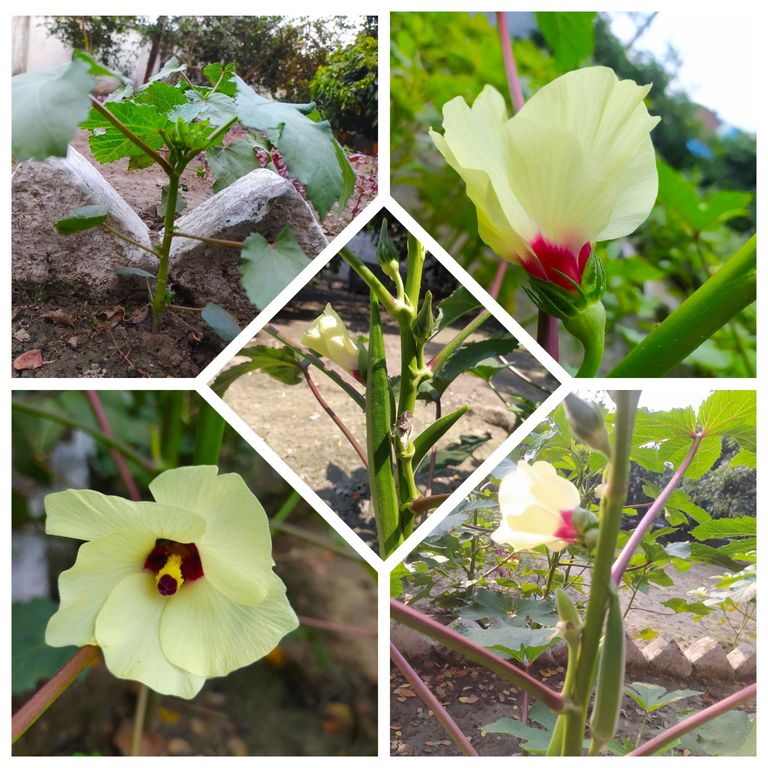
Assalamu Alaikum how are you all I hope you are all well I am also very well by the grace of your great Allah in the meantime I am going to share some things about paddy cultivation let's start.
The popular summer vegetable is rich in vitamins B and C. It also contains enough iodine, vitamin A and various minerals.
So sorghum cultivation has physical benefits as well as economic prosperity. Hybrid varieties can be cultivated almost throughout the year except summer.
It is always best to use fresh seeds for growing sorghum. Farmers will benefit from this. The land that gets the Prothom-alo and air should be selected for cultivation. The land should be elevated and have good drainage facilities.
আসসালামু আলাইকুম আপনারা সবাই কেমন আছেন আশা করি সবাই ভাল আছেন আমিও আপনাদের মহান আল্লাহতালার রহমতে খুব ভালো আছি এর মাঝে ঢেঁড়স চাষ সম্পর্কে কিছু কথা শেয়ার করতে যাচ্ছি চলুন শুরু করা যাক।
গ্রীষ্মকালীন জনপ্রিয় সবজি ঢেঁড়শে প্রচুর পরিমাণে ভিটামিন বি ও সি রয়েছে। এছাড়া পর্যাপ্ত আয়োডিন, ভিটামিন এ এবং বিভিন্ন খনিজ পদার্থ রয়েছে।
তাই ঢেঁড়শ চাষে অর্থনৈতিক সমৃদ্ধির সাথে সাথে শারীরিক উপকারিতাও রয়েছে। হাইব্রিড বা সংকর জাতের ঢেঁড়শ গ্রীষ্মকাল ছাড়াও প্রায় সারা বছরই চাষ করা যায়।
ঢেঁড়শ চাষের জন্য সব সময় নতুন বীজ ব্যবহার করা ভাল। এতে কৃষক লাভবান হবে। ঢেঁড়শ চাষের জন্য প্রথম আলো-বাতাস পায় এমন জমি নির্বাচন করতে হবে। জমি উঁচু হবে এবং পানি নিকাশের ভাল সুবিধা থাকতে হবে।
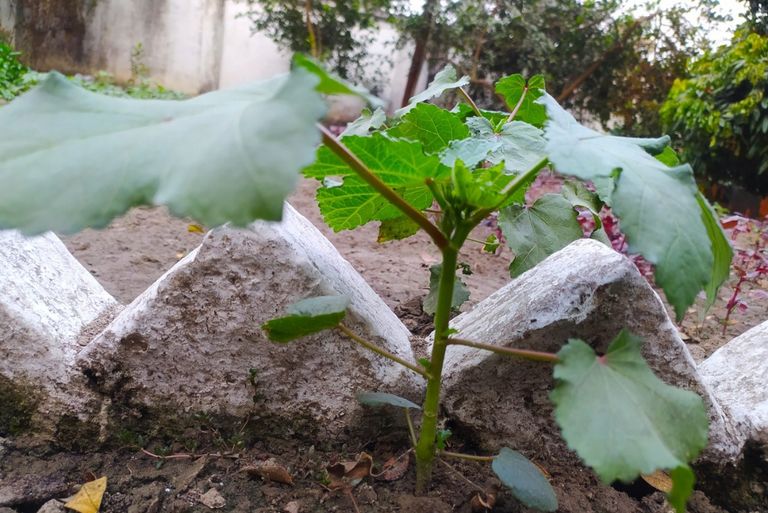
#Rules of cultivation of sorghum-
Bhendi or okra can be cultivated throughout the year. But summer is the perfect time for cultivation. Phalgun-Chaitra and Ashwin-Kartik months are suitable time for sowing seeds.
20 grams of seed per hundred and 4-5 kg per hectare are required for sowing. Loamy and sandy loamy soils are good for paddy cultivation.
Cultivation can also be done on atel soil if there is drainage facility. Shawni, Parbani Kani, Bari Dharsh, Pusha Sawani, Penta Green, Kabuli Dwarf, Japanese Pacific Green are suitable cultivars.
Sorghum Cultivation: Climate and Soil
- Prolonged warm weather is favorable for sorghum cultivation. A large amount of paddy is grown in summer. In prolonged cold weather and frosts, the tree does not survive.
- At temperatures less than 20 degrees Celsius, the seeds do not germinate. In addition to summer, hybrid paddy or okra can be grown in rainy season, even in rainfed areas.
- A light loamy soil with organic matter is ideal for sorghum cultivation, but it can be grown in almost any type of soil. Slight acidity tolerant but does not do well in alkaline or saline soils.
- Hybrid horticulture seeds can be sown from Phalgun month to Shravan month.
ঢেঁড়শ চাষের নিয়ম-
ঢেঁড়শ বা ভেণ্ডী সারা বছর চাষ করা যায়। তবে গ্রীষ্মকাল চাষের উপযুক্ত সময়। ফাল্গুন-চৈত্র ও আশ্বিন-কার্তিক মাস বীজ বোনার উপযুক্ত সময়।
ঢেঁড়শ বপনের জন্য প্রতি শতকে ২০ গ্রাম এবং প্রতি হেক্টরে ৪-৫ কেজি বীজ প্রয়োজন হয়। দো-আশ ও বেলে দো-আশ মাটি ঢেঁড়শ চাষের জন্য ভালো।
পানি নিষ্কাশনের সুবিধা থাকলে এটেল মাটিতেও চাষ করা যায়। শাউনি, পারবনি কানি, বারি ঢেঁড়শ, পুশা সাওয়ানি, পেন্টা গ্রিন, কাবুলি ডোয়ার্ফ, জাপানি প্যাসিফিক গ্রিন চাষ উপযোগী জাত।
ঢেঁড়শ চাষ: জলবায়ু ও মৃত্তিকা
- দীর্ঘস্থায়ী উষ্ণ আবহাওয়া ঢেঁড়শ চাষের পক্ষে অনুকূল। গ্রীষ্মকালেই অধিক পরিমাণে ঢেঁড়স চাষ হয়। দীর্ঘস্থায়ী ঠাণ্ডা আবহাওয়া ও তুষারপাতে ঢেঁড়শ গাছ বাঁচে না।
- ২০ ডিগ্রি সেলসিয়াস এর কম উষ্ণতায় ঢেঁড়শ বীজ অঙ্কুরিত হয় না। গ্রীষ্ম ছাড়াও বর্ষাকালে, এমনকি বৃষ্টিবহুল অঞ্চলেও হাইব্রিড ঢেঁড়শ বা ভেণ্ডী চাষ করা যায়।
- জৈব পদার্থ যুক্ত হালকা দো-আঁশ মাটি ঢেঁড়শ চাষের পক্ষে আদর্শ হলেও প্রায় সবরকম মাটিতেই এর চাষ করা যায়। সামান্য অম্লত্ব সহনশীল হলেও ক্ষার বা নোনামাটিতে ঢেঁড়শ ভালো হয় না।
- ফাল্গুন মাস থেকে শুরু করে শ্রাবণ মাস পর্যন্ত হাইব্রিড ঢেঁড়শ বীজ বোনা যায়।
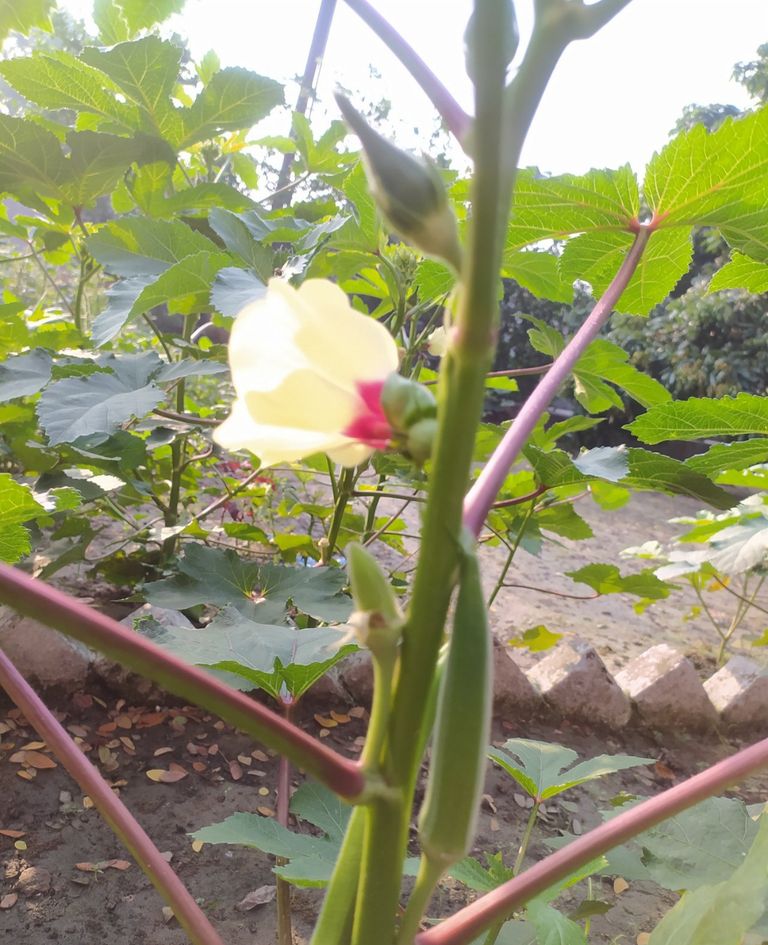
How to sow seeds:
Before sowing seeds, bells should be soaked in water for 10 to 13 hours. The land has to be prepared by deep plowing and harrowing.
Then create a row. The row distance from the ground will be 75 cm.
Sow 2-3 seeds at a distance of 45 cm in the seed row. According to the variety, the distance from seedling to seedling and row to row can be increased or decreased by 15 cm.
Distances can be reduced as trees become shorter in winter. After sprouting, one healthy seedling should be placed in each hole and the rest of the seedling should be removed from the hole.
Fewer seeds are required in rainy season than in summer season. 1-2 kg per bigha of native seed and 500-750 gm per bigha of hybrid seed.
During summer the growth of plants is relatively less. In summer, the row to row distance will be 60 cm. 2 feet and plant to plant distance of 45 cm. 1.5 feet. During monsoon, the distance from row to row will be 75 cm. 2.5 feet and plant to plant distance of 45 cm. 60 cm to 1.5-2 feet.
The land is plowed deeply and mixed with dung manure well with a ladder, after 7 days, 1 or 2 seeds in a row according to the distance, 1 cm. Sow the seed deep.
Soaking the seeds in water for 12-24 hours before planting will improve germination and produce seedlings quickly and evenly.
Okra seeds should be mixed with 2 grams of carbendazim per kg of seeds and the seeds should be cleaned.
Light irrigation should be given after sowing and care should be taken to ensure that the land is neither too wet nor too dry.
Parvani Kranti and Satshira among the native varieties are tolerant to Sahebrog to some extent. However, it is better to grow hybrid varieties of bhendi or bhendi for monsoons.
বীজ বোনার পদ্ধতি:
ঢেঁড়শ বীজ বপণের আগে ১০ থেকে ১৩ ঘণ্টা পানিতে ঘণ্টা ভিজিয়ে রাখতে হয়। মাটি গভীরভাবে চাষ ও মই দিয়ে ঝুরঝুরে করে জমি তৈরি করতে হয়।
এরপর সারি তৈরি করতে হবে। মাটি থেকে সারির দূরত্ব হবে ৭৫ সেন্টিমিটার।
বীজ সারিতে ৪৫ সেন্টিমিটার দূরে দূরে ২-৩টি করে বীজ বুনতে হয়। জাত অনুযায়ী চারা থেকে চারা এবং সারি থেকে সারির দূরত্ব ১৫ সেন্টিমিটার কমানো-বাড়ানো যায়।
শীতকালে গাছ ছোট হয় বলে দূরত্ব কমানো যেতে পারে। চারা গজানোর পর প্রতি গর্তে একটি করে সুস্থ চারা রেখে বাকি চারা গর্ত থেকে উঠিয়ে ফেলতে হয়।
গ্রীষ্মকালের চেয়ে বর্ষাকালে অপেক্ষাকৃত কম বীজ লাগে। দেশী বীজ বিঘা প্রতি ১-২ কেজি এবং হাইব্রিড বীজ-বিঘা প্রতি ৫০০-৭৫০ গ্রাম।
গ্রীষ্মকালে গাছের বৃদ্ধি অপেক্ষাকৃত কম হয়। গ্রীষ্মকালে সারি থেকে সারির দূরত্ব হবে ৬০ সেমি. ২ ফুট এবং চারা থেকে চারার দূরত্ব হবে ৪৫ সেমি. ১.৫ ফুট। বর্ষাকালে সারি থেকে সারির দূরত্ব হবে ৭৫ সেমি. ২.৫ ফুট এবং চারা থেকে চারার দূরত্ব হবে ৪৫ সেমি. থেকে ৬০ সেমি ১.৫-২ ফুট।
জমি গভীরভাবে চাষ ও মই দিয়ে মাটির সাথে গোবর সার ভালোভাবে মিশিয়ে ৭ দিন পরে দূরত্ব অনুযায়ী সারিতে ১টি বা ২টি করে বীজ ১ সেমি. গভীরে বীজ বুনতে হবে।
বীজ বসানোর আগে ১২-২৪ ঘন্টা পানিতে ভিজিয়ে রাখলে অঙ্কুরোদগম ভালো হবে এবং তাড়াতাড়ি ও সুষমভাবে চারা বের হবে।
ভেণ্ডী বীজ ২ গ্রাম কার্বেণ্ডাজিম প্রতি কেজি বীজে মিশিয়ে বীজ শোধন করে নিতে হবে।
বীজ বোনার পর হালকা সেচ দিতে হবে এবং লক্ষ্য রাখতে হবে যেন জমি খুব বেশি ভিজে না যায় বা খুব বেশি শুকিয়ে না যায় ৷
দেশী জাতের ঢেঁড়শের মধ্যে পার্বণী ক্রান্তি ও সাতশিরা কিছু পরিমাণে সাহেবরোগ সহনক্ষম। তবে, বর্ষাকালের জন্য হাইব্রিড জাতের ঢেঁড়শ বা ভেণ্ডী চাষ করা উত্তম।
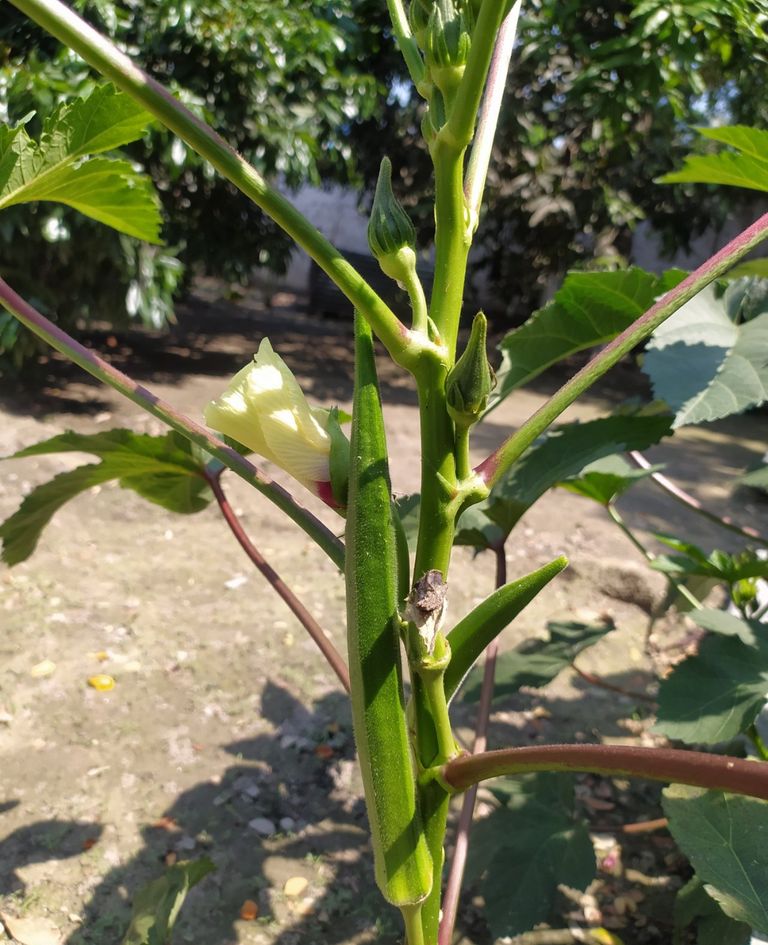
Fertilizer application and maintenance in paddy cultivation:
10 quintals of dry cow dung or composted manure per bigha, 40 kg of super phosphate should be mixed well with the soil before sowing the seeds.
After 40 days of planting seeds in the land, 6 kg of urea fertilizer per bigha should be mixed with the soil.
After the saplings are 5-6 inches, earthworm fertilizer in the amount of 20 grams per seedling is applied from both sides of the row and covered with soil, more yield is obtained.
Apart from this, microbial fertilizers such as Aztobacter and Softica can also be used to produce more sorghum. It will increase the yield per bushel up to 20-30 percent.
2.5 kg of malathion mixed with 5 percent powder insecticide should be applied to the soil at the time of final tillage to prevent insects. Moreover, mixing neem leaves during cultivation will suppress the pests in the soil.
- One month after sowing the seeds, apply nitrogen fertilizer at the rate of 5 kg per bigha and tie the roots with soil at the base of the seedling and irrigate.
- Nitrogen and potash should be applied at the rate of 5 kg each and irrigation should be done as second application three weeks after the first application of fertilizer.
- Weeds should be cleaned from time to time and the soil at the base should be loosened. Irrigation should be done every 7-10 days as needed.
- Harvesting starts after 50-60 days of seed sowing. Every 3/4 days the bhendi should be removed by cutting the tip with a sharp knife. Fruit growth is better at night.
- Time harvesting is more profitable Despite careful and clean cultivation, various diseases and insect attacks occur. In that case, crop protection measures should be taken as required.
ঢেঁড়শ চাষে সার প্রয়োগ ও পরিচর্যা :
ঢেঁড়শ বীজ বোনার আগে জমি চাষের সময় বিঘাপ্রতি ১০ কুইন্টাল শুকনো গোবর অথবা পচন সার, ৪০ কিলোগ্রাম সুপার ফসফেট ভালভাবে মিশিয়ে দিতে হবে মাটির সাথে।
জমিতে বীজ রোপণের ৪০ দিন পর বিঘাপ্রতি ৬ কিলোগ্রাম ইউরিয়া সার মাটির সাথে মিশিয়ে দিতে হবে।
ঢেঁড়শের চারাগুলো ৫ -৬ ইঞ্চি হয়ে যাওয়ার পর প্রতি চারায় ২০ গ্রাম পরিমাণে কেঁচো সার সারির দু’দিক থেকে গোঁড়ায় দিয়ে মাটি দিয়ে ঢেকে দিলে অধিক ফলন পাওয়া যায়।
এছাড়া অধিক ঢেঁড়শ উৎপাদনের জন্য এজটবেকটার ও সফটিকা নামক জীবাণু সারও ব্যবহার করা যেতে পারে। এতে বিঘাপ্রতি ফলন ২০-৩০ শতাংশ পর্যন্ত বেড়ে যাবে।
পোকামাকড় ঠেকাতে মাটিতে শেষ চাষের সময় বিঘাপ্রতি আড়াই কিলোগ্রাম ম্যালাথিয়ন ৫ শতাংশ গুঁড়ো কীটনাশক মিশিয়ে দিতে হবে। তাছাড়া চাষের সময় নিমপাতা মেশালেও মাটিতে থাকা কীটপতঙ্গ দমন হবে।
- বীজ বোনার একমাস পরে বিঘা প্রতি ৫ কেজি হারে নাইট্রোজেন সার প্ররো করে চারার গোড়ায় মাটি দিয়ে গোড়া বেঁধে দিতে হবে ও সেচ দিতে হবে।
- প্রথম চাপান সার প্রয়োগের তিন সপ্তাহ পরে দ্বিতী চাপান হিসাবে পুনরায় ৫ কেজি করে নাইট্রোজেন ও পটাশ প্রয়োগ করতে হবে এবং সেচ দিতে হবে।
- মাঝে মাঝে নিড়ানি দিয়ে আগাছা পরিষ্কার করে দিতে হবে এবং গোড়ার মাটি আলগা করে দিতে হবে। প্রয়োজন মতো ৭-১০ দিন অন্তর সেচ দিতে হবে।
- বীজ বোনার ৫০-৬০ দিনের মাথায় ফসল তোলা শুরু হয়। প্রতি ৩/৪ দিন অস্তর ছুরি দিয়ে বোঁটা কেটে ভেণ্ডী তোলা উচিত। রাত্রের দিকে ফলের বৃদ্ধি ভালো হয়।
- কালে ফসল তোলা অধিক লাভজনক ৷ সযত্ন ও পরিচ্ছন্ন চাষ করা সত্ত্বেও নানা রোগ-পোকার আক্রমণ দেখা দেয়। সে ক্ষেত্রে, প্রয়োজন অনুযায়ী ফসল সুরক্ষার ব্যবস্থা নিতে হবে।
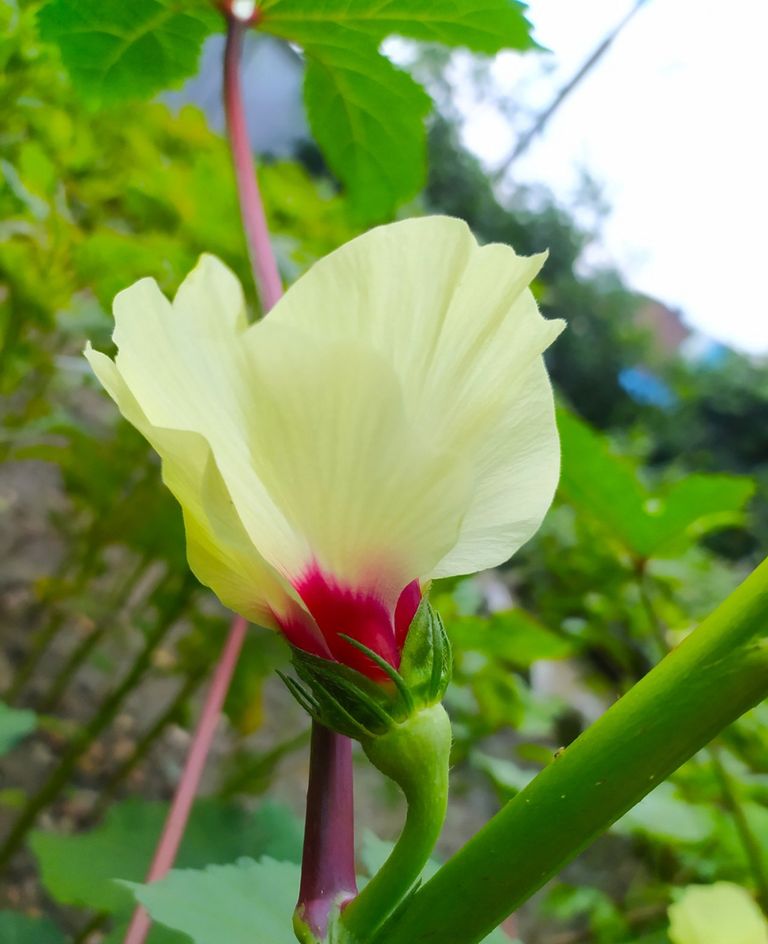
Insect-spider and pest control
The main problem of okra cultivation is this disease. It is a disease caused by a virus.
Leaf veins become yellow and discolored, the veins become thickened and sometimes the interveins become yellow and discolored; And leaves show yellow marks, plant growth is stunted, fruits are small, pale in color, deformed in shape.
Attacked by this fungal disease, the plant turns yellow and becomes stunted, the leaves burn and the plant droops, eventually dying.
Sometimes the plant is fresh, but the buds and fruit are withered. If the root or trunk of a diseased plant is cut lengthwise, long black spots can be seen inside.
If too much, the whole trunk turns black.
Remedies for this disease: Crop rotation, uprooting of diseased plants, deep cultivation in summer are the main ways to avoid this disease.
Besides, if there is a possibility of disease, mancozeb at 2.5 gm per liter and carbendazim at 1 gm per liter should be sprayed in water at intervals of 7 days.
Spots on leaves:
Irregular water spots are seen on the leaves. The spots gradually turn black, the leaves curl, droop and droop. It is a fungal disease.
Treatment of this disease: To control this disease, the same drugs used in prostrate disease should be used in the same dosage.
Nematodes :
Infected plants show root nodules, plant stunting, stunted growth and yield failure. It is almost impossible to directly kill the microscopic worm-like organism called nematode.
Treatment of this disease: This disease can be controlled to some extent by applying drugs like carbofuran mixed with fertilizers.
Apart from this, nematode control can be achieved by cultivating marigolds in infested land and cultivating marigolds in a three-year crop cycle.
পোকা- মাকড় ও রোগ-বালাই দমন
ভেণ্ডী চাষের প্রধান সমস্যা হলো এই সাহেব রোগ। এটি একটি ভাইরাস ঘটিত রোগ।
পাতার শিরা হলুদ ও বর্ণহী হয়ে যায়, শিরা-উপশিরাগুলি মোটা হয়ে যায় এবং কখনও কখনও শিরা-মধ্যবর্তী অংশও হলুদ হয়ে বিবর্ণ হয়ে যায়; এবং পাতাগুলো হলুদ ছাপ ছাপ দেখায়, গাছের বৃদ্ধি ব্যহত হয়, ফল ছোটো ছোটো, ফ্যাকাসে রঙের, বিকৃত আকার-আকৃতি লাভ করে।
ছত্রাকঘটিত এই রোগের আক্রমণে গাছ হলুদ বর্ণ ধারণ করেও বেঁটে হয়ে যায়, পাতা পুড়ে যায় ও গাছ ঝিমিয়ে পড়ে, অবশেষে মরে যায়।
অনেক সময় গাছ সতেজ থাকে, কিন্তু অগ্রমুকুল এবং কচিফল শুকিয়ে যায়।রোগাক্রান্ত গাছের মূল বা কাণ্ড লম্বালম্বিভাবে কাটলে ভিতরে কালোকালো লম্বা দাগ দেখা যায়।
খুব বাড়াবাড়ি হলে পুরো কাণ্ডই কালো হয়ে যায়।
এই রোগের প্রতিকার: শস্যচক্র মেনে চাষ, রোগাক্রান্ত গাছের মূলসহ তুলে ফেলা, গ্রীষ্মকালে গভীর চাষ-এই রোগের হাত থেকে রক্ষা পাওয়ার প্রধান উপায়।
এছাড়া, রোগের সম্ভাবনা দেখা দিলে ২.৫ গ্রাম প্রতিলিটার হিসাবে ম্যানকোজেব এবং ১ গ্রাম প্রতিলিটার হিসাবে কার্বেন্ডাজিম জলে গুলে পর্যায়ক্রমে ৭ দিন অন্তর স্প্রে করতে হবে।
পাতায় দাগ :
পাতায় গোলগোল জলবসা দাগ দেখা যায়। দাগ ক্রমশঃ কালচে রং ধারণ করে, পাতা গুটিয়ে যায়, ঝিমিয়ে পড়ে এবং ঝুলে পড়ে। ছত্রাকঘটিত রোগ এটি।
এই রোগের প্রতিকার: এ রোগ নিয়ন্ত্রণের জন্য ঝিমিয়ে পড়া রোগে যে ওষুধ ব্যবহার করা হয়, সেই একই ওষুধ একই মাত্রায় ব্যবহার করতে হবে।
নিমাটোড :
আক্রান্ত গাছের শিকড়ে গাঁট গাঁট ফোলা অংশ দেখা যায়, গাছ ঝিমিয়ে পড়ে, বৃদ্ধি কমে যায় এবং ফলন হল না। সরাসরি নিমাটোড নামক আণুবীক্ষণিক কৃমি জাতীয় জীবটিকে মেরে ফেলা প্রায় অসম্ভব।
এই রোগের প্রতিকার: কার্বোফিউরান জাতীয় ওষুধ সারের সঙ্গে মিশিয়ে জমিতে প্রয়োগ করে এই রোগ কিছুটা নিয়ন্ত্রণে আনা যায়।
এছাড়া, আক্রান্ত জমিতে গাঁদা ফুলের চাষ করে এবং তিন বছর শস্যচক্রে ভেণ্ডীর চাষ করে নিমাটোডের হাত থেকে নিস্তার পাওয়া সম্ভব।
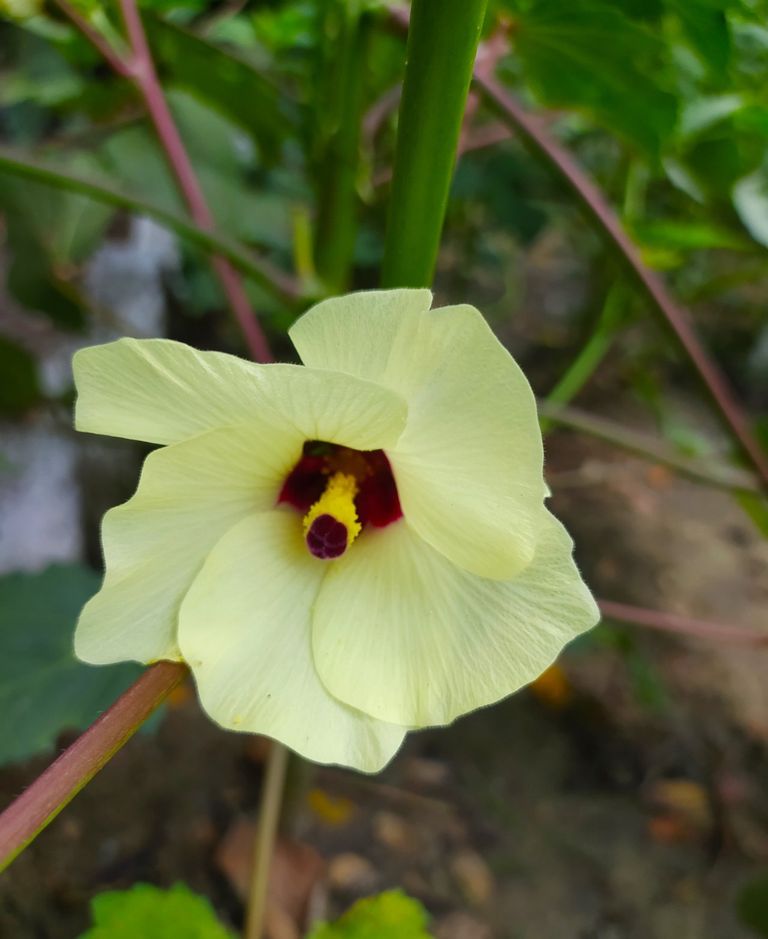
Suckers :
Tiny insects absorb sap from young leaves. As a result, the leaves gradually turn brown and curl The plant becomes weak and growth slows down.
Treatment of this disease: Dimethoate should be sprayed every 7 days at the rate of 2 ml per liter of water until flowering.
Spider :
Tiny yellow and red spider mites nest under the leaves and suck the sap, weakening the plant. Affected leaves turn yellow and curl downwards, flowers and fruits do not hold.
Treatment of this disease: Dicofol 1.5 ml/l before flowering on affected plants. Ethion 1 ml/l in water and on fallen plants. Dissolve in water and spray every 7 days.
Fruit borers :
Small insects pierce the fruit and live inside the fruit and eat and destroy the fruit. Many times the young tip pierces and causes great damage to the crop.
Remedy for this disease: Quinalfos 2 ml in the evening. This insect can be controlled by spraying every 7 days in 1 liter of water. Besides, thiodicarb 1ml/l. Dissolve in water and spray every 7-10 days.
While the green bland and fiber-rich vegetable may not be a favorite of many, radishes do have some health benefits. For example-
For Diabetic Patients: Turmeric contains ingredients that lower the body's glucose levels and a type of fiber that keeps the body's sugar under control.
Prevention of Anemia: Hemoglobin, iron and vitamin K (K) in saffron prevents blood clotting problems in the body. It produces the necessary red platelets in the body and prevents the weakness of the body. Therefore, it is good to eat more saffron in the problem of anemia.
Vibrant Hair: The delicious vegetable is very beneficial for curly hair and contains certain ingredients that act as hair conditioners. Prevents dandruff and lice, relieves scalp dryness and itching and keeps hair healthy.
To lose weight: The fiber of rind keeps the stomach full for a long time and the vitamin content remains in the body for a long time and the calorie content of rind is very low.
To keep cholesterol level in check: The fiber and pectin in oats keep bad cholesterol levels in check in the body.
চোষী পোকা :
অতি ক্ষুদ্র পোকা কচি পাতার রস শোষণ করে। ফলে, পাতাগুলি ক্রমশঃ বাদামি রং ধারণ করে কুঁকড়ে যায় ৷ গাছ দুর্বল হয়ে পড়ে ও বৃদ্ধি কমে যায়।
এই রোগের প্রতিকার: ফুল আসার আগে পর্যন্ত ডাইমিথয়েট প্রতিলিটার জলে ২ মিলিলিটার হারে ৭ দিন অন্তর স্প্রে করতে হবে।
মাকড় :
অতি ক্ষুদ্র হলুদ ও লাল মাকড় পাতার নিচে বাসা বাঁধে ও রস শোষণ করে গাছকে দুর্বল করে দেয়। আক্রান্ত পাতা হলুদাভ হয়ে নিচের দিকে কুঁকড়ে যায়, ফুল ও ফল ধরে না।
এই রোগের প্রতিকার: আক্রান্ত গাছে ফুল আসার আগে ডাইকোফল ১.৫ মিলি/লি. জলে এবং ফলন্ত গাছে ইথিয়ন ১ মিলি/লি. জলে গুলে ৭ দিন অন্তর স্প্রে করতে হবে।
ফল ছিদ্রকারী পোকা :
ছোটো ছোটো কীড়া ফল ছিদ্র করে ফলের মধ্যে বাস করে ও ফল খেয়ে নষ্ট করে। অনেক সময় কচি ডগা ছিদ্র করে ফসলের প্রভূত ক্ষতি সাধন করে।
Excellent guide, greetings.
I’m glad you found the guide helpful. Thank You so much for your support.